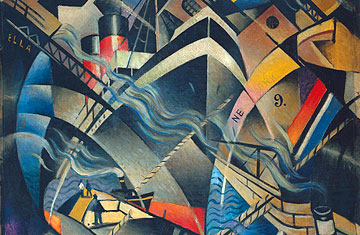
Dynamic: Futurist art like Christopher Nevinson's The Arrival (1913) emphasized motion
It's 100 years since the Italian futurists declared in a manifesto their intention to find a new way of representing "our whirling life of steel, of pride, of fever and of speed." They loved modernity and machinery, and the movement's founder, Filippo Tommaso Marinetti, even welcomed war as "the world's only hygiene."
"Futurism," at London's Tate Modern from June 12 to Sept. 20, shows what happened when the Italians collided with French, Russian, British and American painters. After a visit to Paris in 1911, they borrowed the Cubists' fragmented forms and variable viewpoints, while the Cubists became more louche and vivid under Italian influence. (See 10 things to do in London.)
The Technical Manifesto of Futurist Painting declared: "The motor bus rushes into the houses which it passes, and in their turn the houses throw themselves upon the motor bus and are blended with it." Carlo Carrà captured this energy in the kaleidoscopic What the Tram Told Me (1911), while Umberto Boccioni conveys the rush of rail travel in his triptych States of Mind (1911). The second painting in the series, Those Who Go, depicts giant dreaming heads swept along with fragmentary buildings, leaving faded gray figures marooned on the platform in the third panel, Those Who Stay.
Futurism itself was pretty much over by 1915 — the end point of the show. Briton Christopher Nevinson painted vorticist soldiers, Italian Gino Severini created some fractured war scenes, like Red Cross Train Passing a Village (1915), and the Russian Kazimir Malevich's figures seem constructed out of shell cases. This show is a chance to appreciate these artists and their youthful enthusiasm, before the first mechanized war crushed both.
Got an awful travel gripe? The Avenger may be able to sort it out for you. Click here to tell us your problem.
